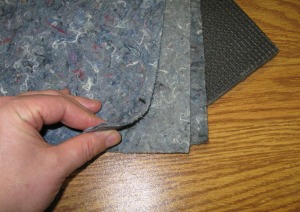It’s amazing how such a short, simple question requires a lengthy, complicated answer. When it comes to sound insulation, some folks are concerned about noise from the outside, but most are concerned about noise between floors and walls inside the home. So lets focus on interior sound insulation and leave the exterior for another time.

There are really two types of sound that we need to tackle. First, there is air-born sound like music. Second, there is the impact sound like shoes on tile and wood. Each requires different solutions.
Sound Insulation for Air-born Noise
- Adding Mass Between Spaces – This can be done with extra layers of drywall or subfloor decking. A thicker wall or floor will reduce air-born noise.
- Putting Gaps In The Structure – This can be done by using two sets of framing studs in a wall. This creates a cavity in the wall that will reduce noise.
- Closing Air Holes Between Spaces – Air-born sound can travel through key-holes, around pipes and through outlets. Make sure these gaps are caulked and sealed.
- Putting Dampening Elements In The Voids – Fiberglass and cellulose insulation absorbs air-born noise. It’s like putting a sock inside a guitar. The air between two sheets of drywall can’t transmit noise efficiently when it’s filled with fluff.
- Using Special Materials – There are membranes that can be placed in walls (Accoustiblock), multi-layer drywall (QuietRock) and other products that can reduce air-born noise, but pay attention to the costs of these materials.
Sound Insulation for Impact Noise
- Stopping the Source – Apartment leases used to require tenants to cover a percentage of their flooring with rugs. The idea was to lessen the impact directly to the floors. Similarly, putting pads under washers and dryers can lessen vibration.
- Separating Surfaces – This can be done by adding a layer between the sub-floor and the flooring. There are a variety of products such as Gypcrete, Homasote and materials made of recycled rubber or cork.
- Reduce Retransmission - Add an element that doesn’t allow the ceiling drywall to directly contact the floor trusses. This can be done with resilient channels. The impact vibration will travel from the floors to the trusses, but is dampened in these channels and not transmitted through the drywall into the room below.
As I mentioned at the beginning, this short and simple question doesn’t have a brief answer, but it does have a solution. If you are concerned about sound insulation in your custom Tampa home, contact us to discuss it.
Follow us on our Blog & Social Network -
Javic Blog: http://javichomes.wordpress.com/
Facebook: http://www.facebook.com/javichomes
Twitter: http://twitter.com/#!/javichomes
YouTube: http://www.youtube.com/user/jondsolomon?feature=mhum

Comments(4)